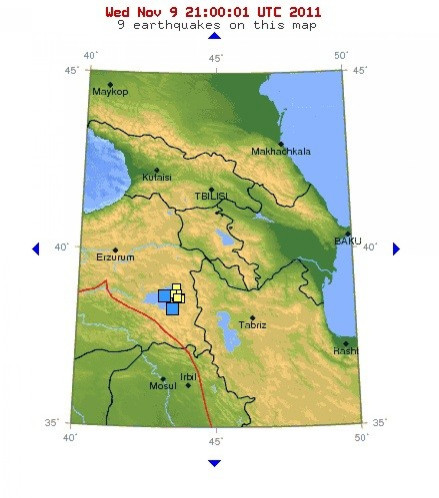Turkey Earthquake: More Deaths in Quake Prone Van
ANALYSIS

In Turkey, a magnitude 5.7 earthquake struck near the city of Van, collapsing a number of buildings and sending residents running into the street.
It was the first earthquake to cause significant damage since a 7.2 magnitude quake hit the same area on Oct. 23, and with three people now confirmed dead and 50 more still trapped under a collapsed hotel, it will sadly also be the first to have any casualties.
So far, 11 people have been rescued and workers are still digging people out from under the rubble, including two CNN reporters who were trapped when a hotel fell.
The epicenter of the earthquake was nine miles south of Van, which is located on the Iranian border of Turkey, about 580 miles from the capital of Ankara. It happened at a depth of three miles.
In the past week alone there have been nine earthquakes of magnitude 3.0 or higher in the area, according to the U.S. Geological Survey, the two largest occurring on Wednesday. A day earlier, there was a 5.6 magnitude quake only miles away from where Wednesday's hit, and all other the other quakes this week have been of magnitude 4.5 or higher.
While eastern Turkey is particularly vulnerable to quakes, all the recent movement is likely caused by tectonic shifts resulting from changes in the Earth's crust after the October earthquake. In less than three weeks, there have been about 14,000 aftershocks in the area.
Turkey's Shaky History
More than 600 people died after the October quake, despite a massive rescue effort. Search-and-rescue teams worked 24 hours a day to dig through the rubble of hundreds of collapsed buildings and destroyed homes to pull out survivors, sometimes days after they were trapped in concrete tombs.
There are three major fault lines running through Turkey: the North Anatolian Fault, the East Anatolian Fault and the Bitlis-Zagros Fold and Thrust Fault, all of which converge about 120 miles north west of Van. Additionally, three tectonic plates meet in Turkey -- the Anatolian Plate, the Eurasian Plate and the Arabian Plate -- making it particularly susceptible to earthquakes.
A report on the Oct. 23 quake from the Southern California Earthquake Center notes that Turkey is a tectonically active country that experiences frequent destructive earthquakes.
The report gets technical after that, but confirms that plate movement was responsible for the natural disaster.
On a broad scale, the seismtectonics of the region near the October 23, 2011 earthquake are controlled by the collision of the Arabian Plate and Eurasian plates; at the latitude of this event, the Arabian plate converges with Eurasia in a northerly direction at a rate of approximately 24 mm/yr.
The October earthquake was the worst in Turkey since the 1999 ?zmit earthquake that killed more than 17,000 people, injured 50,000 and left 60,000 more homeless (It occurred on the North Anatolian fault). The worst ever quake in modern Turkish history occurred in December 1939 in the in the Erzincan Plain. The 7.8 magnitude quake killed a reported 32,700 people can could be felt in Cyprus, Russia and Ukraine.
Earthquakes in Turkey, although both destructive and tragic, are not unusual. Yet, 2011 has seen its share of large-scale quakes. In March, a 9.0 earthquake hit Japan, causing enormous damage and a nuclear disaster at the Fukushima power plant. A month earthlier, a 6.3 magnitude earthquake in Christchurch, New Zealand killed nearly 200.
On Sept. 6, a 6.6 magnitude earthquake hit the Indonesian island of Sumatra, killing a 12-year-old boy who was lying in bed and a man who died of a heart attack as he fled his home. Two separate earthquakes caused massive damage in India earlier this fall.
There were also significant earthquakes across the United States, including San Francisco, Denver and the Virginia earthquake that was felt up and down the East Coast. On Monday, Oklahoma experienced its biggest earthquake ever, a 5.6 magnitude earthquake in Lincoln County that occurred less than 24 hours after a 4.7 magnitude quake hit in almost the exact same spot.
Is the recent earthquake rate anything to worry about?
Considering that there are about 1.5 million earthquakes a year, not really. And that's just above magnitude 2.0. Below that, there are more millions. In the past week, there have been about 300 total earthquakes in Alaska alone.
Earthquakes have jumped into the international consciousness most especially after the Fukushima disaster in March. An earthquake, tsunami and subsequent nuclear disaster killed more than 15,000 people and shocked the world. Since then, each disaster has attracted a new level of attention and fear.
Still, the events in Turkey and around the world are tragic and frightening and should not be downplayed.
© Copyright IBTimes 2024. All rights reserved.




















